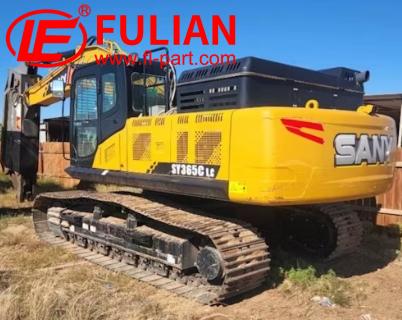To determine if the sprocket on your heavy excavator is defective or in need of replacement, there are several indicators to which you should pay close attention. Here are the signs and explanations that encompass approximately 400 words:
1. Excessive Wear: The most obvious sign of a bad sprocket is visible wear. Check the teeth of the sprocket; they should be uniformly shaped and sized. If you notice that the teeth are worn down, particularly if the wear is uneven or there are teeth missing, this suggests that the sprocket is reaching the end of its service life. The teeth should have a flat top and a symmetrical profile; excessive wear can often give them a sharp or hooked appearance.
2. Noise and Vibration: When a sprocket is failing, abnormal noises and vibrations may be present during operation. If you hear grinding, squealing or other unusual sounds coming from the sprocket area, this can be an indicator of bad sprockets. Vibration could also be a sign of misalignment or damaged sprocket teeth, which can reduce the efficiency of your excavator and lead to further equipment damage if not addressed.
3. Chain Slack or Jumping: A faulty sprocket can cause excessive slack or result in the chain jumping off the sprocket. This can occur if the sprocket teeth are not engaging well with the chain due to wear or damage. In some cases, the chain may slip or skip teeth, which can be both inefficient and potentially hazardous.
4. Visible Cracks or Damage: A visual inspection might reveal cracks, fractures, or other forms of damage on the sprocket. These defects can compromise the strength and integrity of the sprocket, leading to failure under operating stress.

5. Improper Sprocket and Track Alignment: The sprocket should be aligned correctly with the tracks. Misalignment can lead to uneven wear of the sprocket and track, reducing the effectiveness and lifespan of both components. Make sure the sprockets are properly aligned with the tracks and look for any sign of misalignment.
6. Increased Operational Temperature: A defective sprocket can increase friction, which in turn raises the temperature of the area around it. If the sprocket or the chain feels unusually hot after operation, it could be a sign of concern.
7. Difficulty in Rotation: If the sprocket does not turn freely or shows resistance when the excavator is in neutral, this might be an indication of a problem. Rotation issues can stem from damaged teeth or poor fitment with the chain, causing resistance and hindering movement.
Regular inspection of your heavy equipment is essential to maintain performance and safety. If you observe any of these signs, it’s important to address the issue promptly. Failure to do so can lead to more serious mechanical problems, reduce the operating efficiency of the excavator, and may pose safety risks. Depending on the severity of the wear or damage, you might need to repair or completely
Fulian Operation Team
2024.4.23








